2020.05.04.14
Files > Volume 5 > Vol 5 No 4 2020
INVESTIGATION / RESEARCH
Composition and Occurrence of Fish Fauna from Thanbyuzayat Township, Mon Coastal Area
Zarni Ko Ko
Available from: http://dx.doi.org/10.21931/RB/2020.05.04.14
ABSTRACT
A total of 48 species of fish fauna were identified during the present study period. The dominant species of fish were found under order Perciformes in all study areas. The most species composition (40) was recorded in Setse fish landing area. The commercially important fish species were mostly found in Kyaikkhami area. Moreover, 17 species of fish were exported to other regions and foreign countries. Among the fish species, species such as Threadfin (Polynemidae), Croaker (Sciaenidae), Hilsa (Clupeidae), Bombay duck (Harpadontidae), Anchovy (Engraulidae), and Pomfret fish (Stomateidae) were the most economically important species. Bombay duck and Anchovy (especially Coilia dussumieri) were more abundant (70%) at the present study sites. Harpodon nehereus and Coilia species were the leading food employed as fresh and dried for local people in the present study areas.
Key words: Ichthyology, Taxonomy, Compositions, Occurrence, fish landing centers, Thanbyuzayat Township, Mon Coastal Areas.
INTRODUCTION
Myanmar is endowed with natural resources, including rich and various aquatic fauna and flora due to her diversified and the most favorable climate, topography, and habitats. Mon State is located between Latitude 15º 10' N and 17º 30' N and Longitude 96º 46' E and 98º15' E with a unique ecosystem. The Gulf of Mottama faced the Bay of Bengal on the East and the Andaman Sea in the south. This gulf is situated at the mouth of the Sittaung and the Thanlwin Rivers along with the two small rivers, the Gyine and the Attaran. This coastal area is characterized by the fluctuations of seawater flood and freshwater discharge. Mon State areas are covered with estuarine regions characterized by a variable salinity, a temperature range more significant than the sea, and turbid water and muddy bottom (Ohmar Min 1). Economically, the fish component is a significant group of animals. Fish and fish products are an essential part of the diet in Mon State.
Both freshwater and marine fisheries are essential in Myanmar since the local people's livelihood from riverine areas, and the coastal areas depend on the fishes and fisheries. Fisheries are a critical commercial function and domestic or export role to South East Asia and worldwide to earn foreign currency (Ohmar Min1). Ish is one of the most critical animal protein resources in Myanmar. They can be utilized as food in many ways, such as dried, salted, smoked, paste, sauce, and fresh state locally and export to many other countries for commercial purposes. This study aims to determine fish species compositions and to analyze species distributed in Thanbyuzayat Township.
MATERIALS AND METHODS
Study areas
Fish samples were collected from the fish landing centers of Thanbyuzayat Township. The study areas were chosen at three sites, namely Kyaikkhami (Lat. 16° 03¢N, Long. 97° 33¢ E), Setse (Lat. 15° 56¢N, Long. 97° 37¢ E) and Sinpone (Lat. 16° 03¢N, Long. 97° 33¢ E). Kyaikkhami landing site was the main landing center along with the Thanbyuzayat Township. Moreover, in Setse and Sinpone, the bag net fishery was mainly conducted in this Township. The locations of fish landing sites were shown in Figure 1.
Sampling and identification of specimens
This study was conducted at Kyaikkhami, Siphone and Setse, situated at the of Thanlwin River mouth, from June 2019 to May 2020. Color patterns and measurements of the samples were recorded immediately after collections. The specimens were transported with icebox containing ice. The collected specimens were then preserved in 10% formaldehyde in seawater under room temperature within one week. The specimens examined visually were deposited in the Department of Marine Science, Mawlamyine University, Mawlamyine. The species' identification was based on external morphological characters followed by Carpenter, Krupp, Jories and Zajonz2, Fischer and Bianchi3, Day4, Mya Than Tun5, and Sann Aung6.
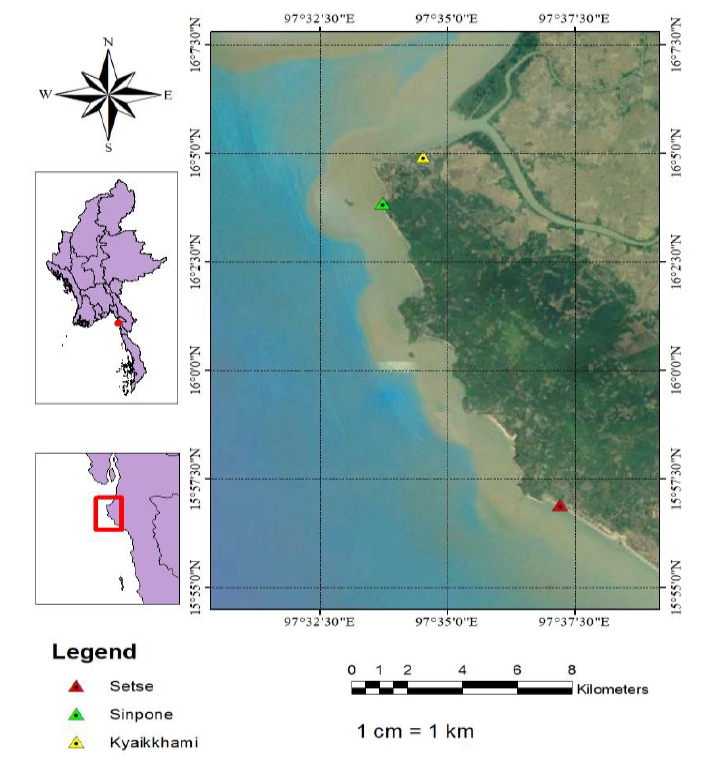
Figure 1. Map showing the fish landing centers during the present study.
RESULTS
Fish Composition and Occurrence
In the present study, the highest number of species (40) was found in Setse, followed by Kyaikkhami (35) and Sinpone (32) sites (Table 1 and Figure 2). The present study results revealed that 48 fish species' occurrence belongs to 12 orders, 31 families, and 42 genera (Figure 3). A list of fish species, including their order, family, species, common name, and local name, was recorded in the present investigation was given in Table 1. During the present study period, Order Perciformes was dominant represented 22 species with 45.83% contribution of the total species followed by Clupeiformes with 11 species (22.92%), Tetrodontiformes with 3 species (6.25%) and Mugiliformes, Pleuronectiformes and Siluriformes each with 2 (4.17%) species, Carcharhiniformes, Myliobatiformes, Torpediniformes, Anguilliformes, Beloniformes and Gadiformes each with 1 (2.08%) species (Table 2). Out of 42 genera reported, Perciformes contributed 47.62%, i.e., 20 followed by Clupeiformes with 8 (19.05%), Tetrodontiformes with 3 (7.19%), Mugiliformes and Siluriformes each with 2 (4.76%), Carcharhiniformes, Myliobatiformes, Torpediniformes, Anguilliformes, Beloniformes, Gadiformes and Pleuronectiformes each with 1 (2.38%) (Table 2). Out of 31 families recorded, order Perciformes contributed 15 (48.39%) families followed by Clupeiformes with 4 (12.90%) families, Siluriformes and Tetrodontiformes each with 2 (6.45%) families, Carcharhiniformes, Myliobatiformes, Torpediniformes, Anguilliformes, Beloniformes, Gadiformes, Mugiliformes and Pleuronectiformes each with 1 (3.23%) families (Table 2). In the present study, the species ranged from 32 and to 40. The previous study reported in Table 3 that it was similar to the present study areas.
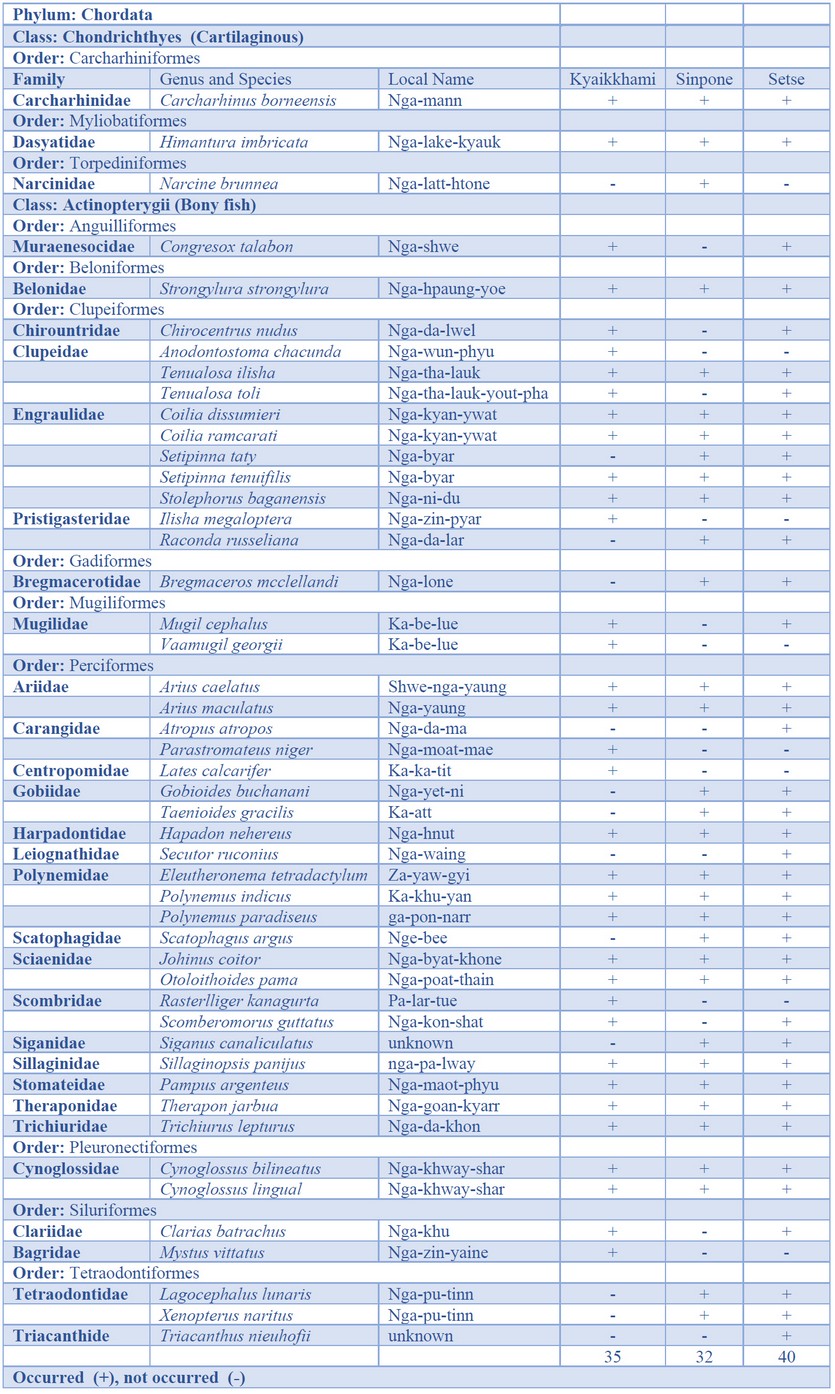
Table 1 Classified list and Species composition of some fish from Fish landing centers during study period.
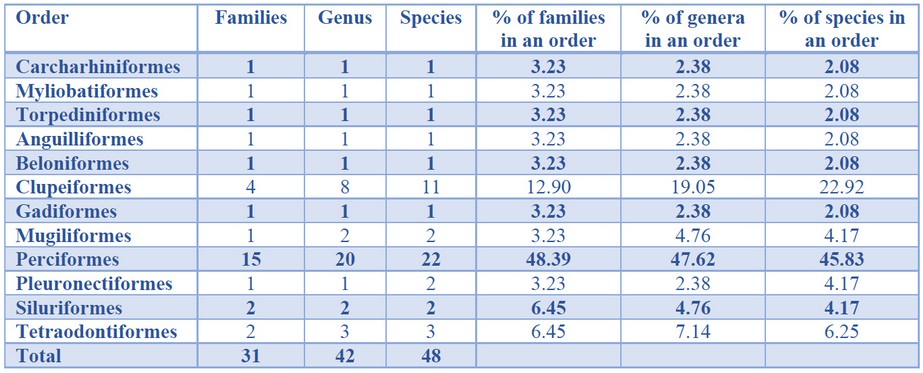
Table 2. Number and percent composition of families, genera, and species of fish under various orders.
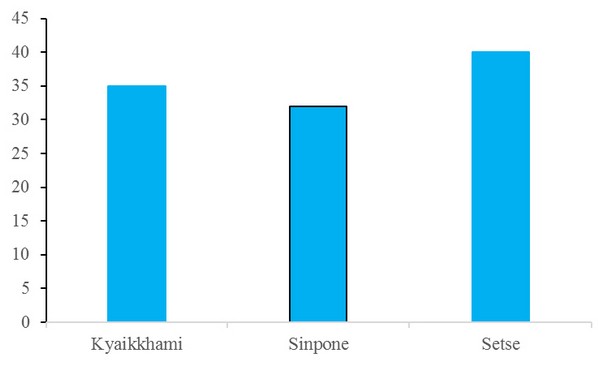
Figure 2. Fish species composition reported in Fish Landing Areas
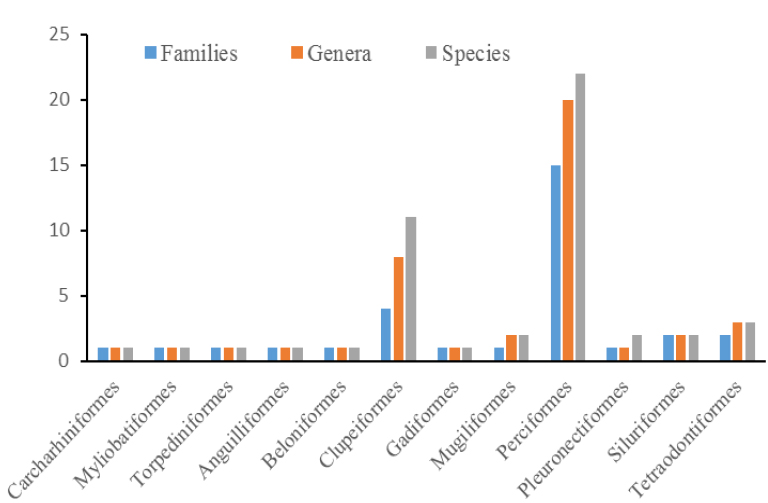
Figure 3. Composition of different fish taxa recorded from Kyaikkhami, Sinpone and Setse Fish Landing Areas.
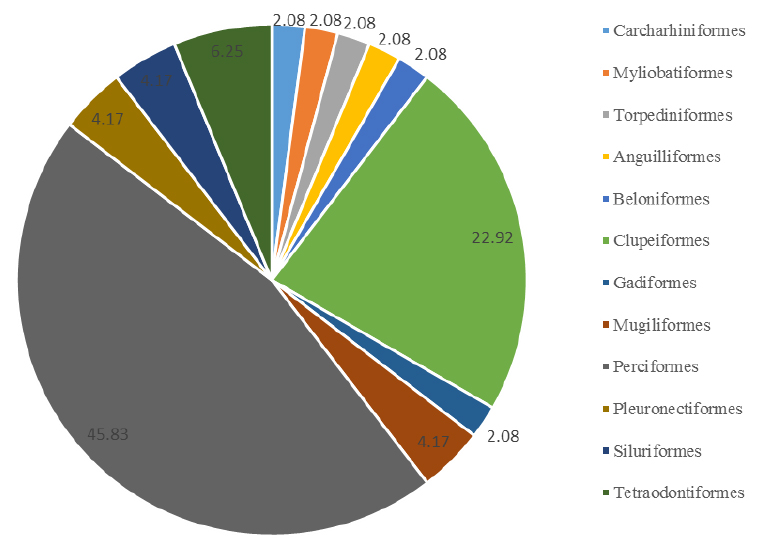
Figure 4. Percentage contributions of Species to the Orders
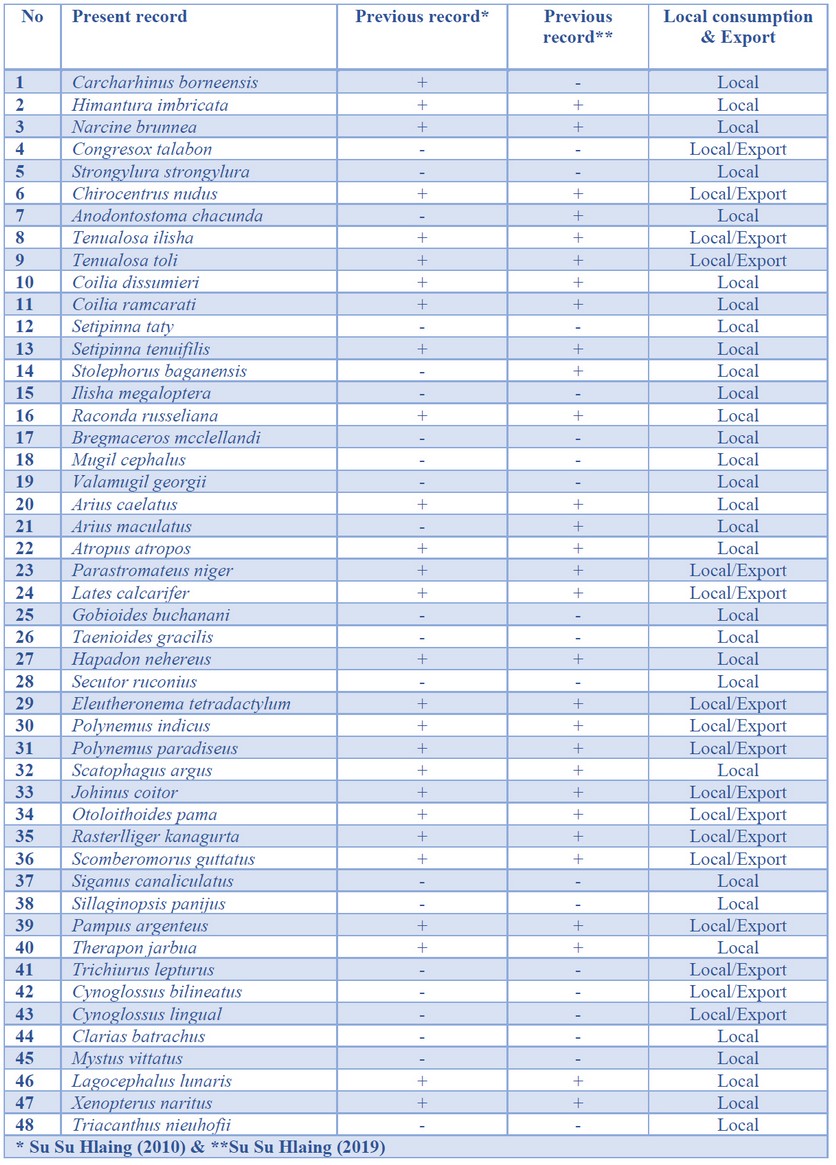
Table 3. A comparison of fish species' occurrence and their local consumption role and export during the present study.
DISCUSSION
In the present study, 48 fish species belong to 12 orders, 31 families, and 42 genera were recorded. During the present study period, Perciformes was the most dominant order in all orders. In some previous studies from Myanmar Coastal Waters, Su Su Hlaing 7 reported 70 species to belong to 61 genera under 42 families of 15 orders from Thanlwin River mouth and the adjacent sea. Moreover, Cho Cho Latt 8 found 5 species of Anchovy (Family Engraulidae), and Thazin Aye 9 identified 6 species of Family Engraulidae, but only five species were recorded in the present study. Setipinna wheeleri and Thryssa hamiltonii was not found in the present study. Thu Ya Kyi Zin 10 51 species from Thalwin River mouth, Zin Zin Zaw 11 35 fish species in Asin Coastal areas. Min Ye Lwin Oo 12 observed Chirocentrus nudus and C. dorab in Zeephyuthaung; however, only C. nudus has occurred in the present study.
Thandar Aung 13 described 27 species of family Carangidae from Tha-baw-seik, Khin Myo Myo Tint 14 47 species of fish from Ka-byar-wa area (Ye Township), Yin Yin Win 15 61 species from Andin Village (Ye Township), Khin Myo Myo Tint 16 69 fish species around Mein-ma-hla Island, Kaung Htet Hein 17 25 species from Kadonebaw Village (Mudon Township). Wint Thuzar New 18 also reported 40 species along Attran ang Gyain River, and Su Su Hlaing 19 observed 96 species of fish belong to 71 genera under 48 families of 17 orders from Thanlwin River mouth and adjacent waters. (Figure 4)
In the present study, species ranged from 32 to 40. The fish species such as Strongylura strongylura, Coilia dissumieri, C. ramcarati, Setipinna tenuifilis, Arius caelatus, A. maculatus, Hapadon nehereus, Polynemus indicus, P. paradiseus, Johinus coitor, Otoloithoides pama, Sillaginopsis panijus, Pampus argenteus, Therapon jarbua, Trichiurus lepturus, Cynoglossus bilineatus and C. lingual were commonly found in present study areas. Su Su Haling 7 also reported that Coilia dissumieri, C. ramcarati, Setipinna tenuifilis, Arius caelatus, A. maculatus, and Hapadon nehereus were commonly found in Setse areas. In the present study, T. lepturus (Family- Trichiuridae) was found, but L. savala and T. lepturus were reported by Ei Ei Khaing 20. In the present study, two species of Atropus atroposa and Parastromateus niger under Carangidae were found while 27 species of Carangidae were found in Tha-baw-seik, Longlone Township (Thandar Aung13). In the previous study, Su Su Hlaing 7 recorded 56 species in Setse and Kyaikkhami areas while 40 species in Setse and 35 species in Kyaikkhami areas during the present study period. Moreover, Su Su Hlaing 20 also reported 71 species in Kyaikkhami area and 69 species in Setse area, respectively.
Sekhara Ra, Simhachalam, and Sebastian Raju 21 reported Mystus vittatus and Clarias batrachus are of high economic importance in Andhra Pradesh, India M. vittatus was low economic value in present study areas. Mohanty et al. 22 reported 317 species (18 cartilaginous and 299 bony fishes) belonging to 207 genera, 88 families, and 23 orders in Chilika Lake, Odisha, India 1916-2014. In the present study, only 3 species of cartilaginous fish (C. borneensis, H. imbricate and N. brunnea) were found. Niloy Kundu et al. 23 also reported 31 species in the intertidal mudflats of Indian Sundarbans. In the present study, Bombay duck and Anchovy were more in abundance at all study sites. Among the anchovies' species, C. dussumieri and H. nehereus were the most abundant species in the catches of bag net fishery and popularly consumed in Mon State and exported to other regions dried product. Su Su Hlaing 20 also recorded Coilia dussumieri was the most abundant species in the catches of bag net fishery and popularly consumed in Mon State. In present study areas, some fishes such as P. indicus, P. paradiseus, H. nehereus and C. dussumieri were highly valued and favored by local people in Mon State. ( Figures 5.6.7.8)
Otherwise, some economic species are considered value, abundance, and local demand and export. And the fishes were utilized as food in various ways such as fresh, dried, salted, smoked, and even some trash fishes can be made as fish paste and fish sauce. H. nehereus was the most popular fish food as fresh and production of dried fishes in Mon Coastal Region.
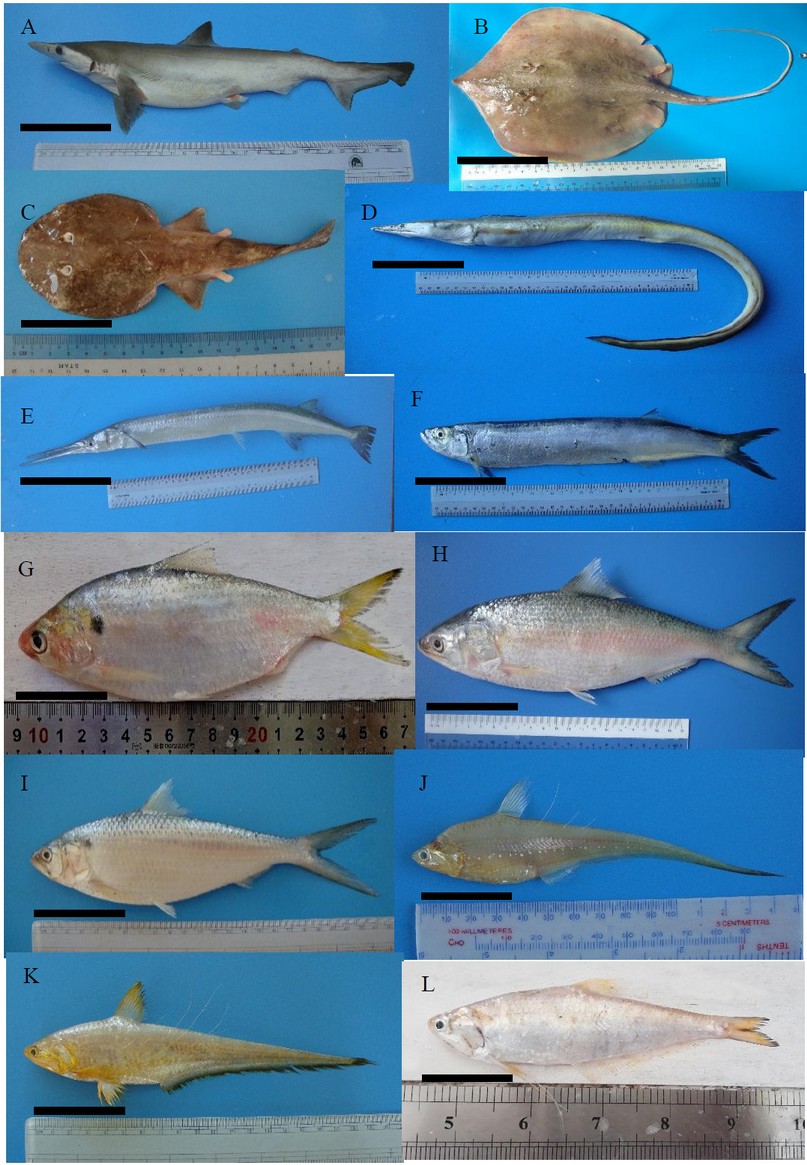
Figure 5 (A-L): A) Carcharhinus borneensis, B) Himantura imbricate, C) Narcine brunnea, D) Congresox talabon, E) Strongylura strongylura, F) Chirocentrus nudus, G) Anodontostoma chacunda, H) Tenulosa ilisha, I) Tenulosa toli J) Coilia dussumieri, K) Coilia ramcarati and L) Setipinna taty (Scale bar= 5cm)
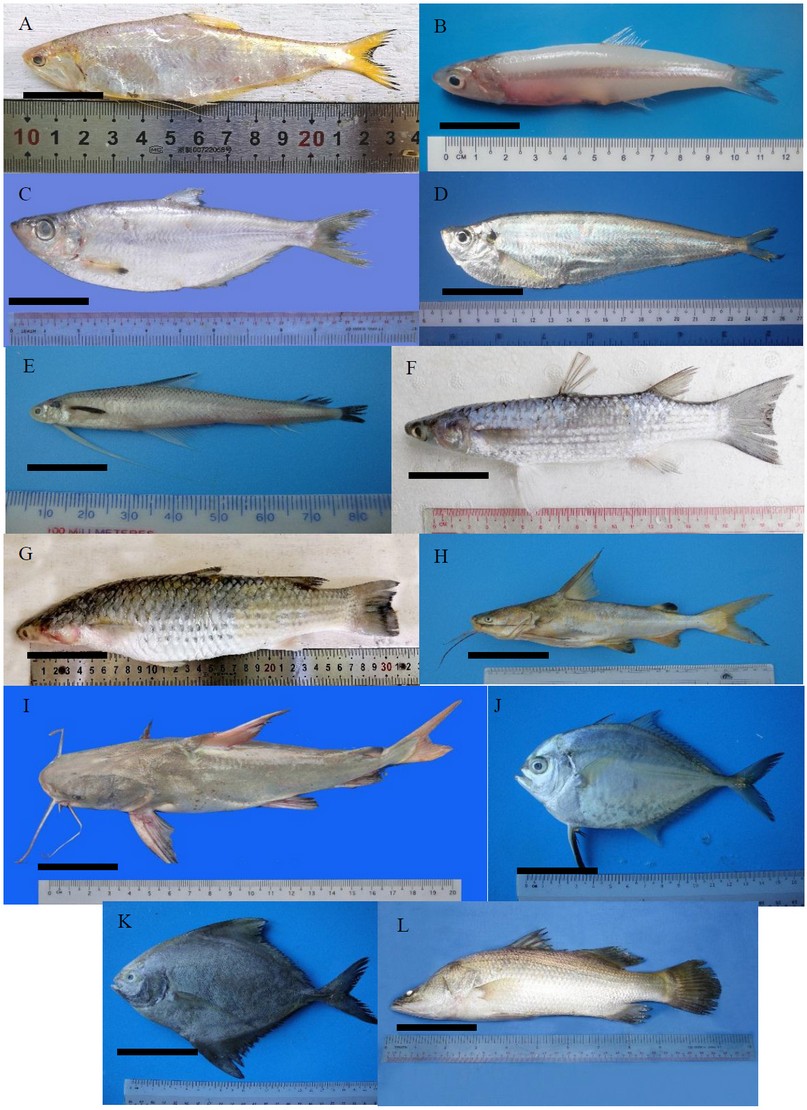
Figure 6 (A-L): A) Setipinna tenuifilis, B) Stolephorus baganensis C) Ilisha megaloptera, D) Raconda russeliana, E) Bregmaceros sp, F) Mugil cephalus, G) Valamugil georgii, H) Arius caelatus, I) Arius maculatus, J) Atropus atropos, K) Parastromateus niger and L) Lates calcarifer (Scale bar= 5cm)
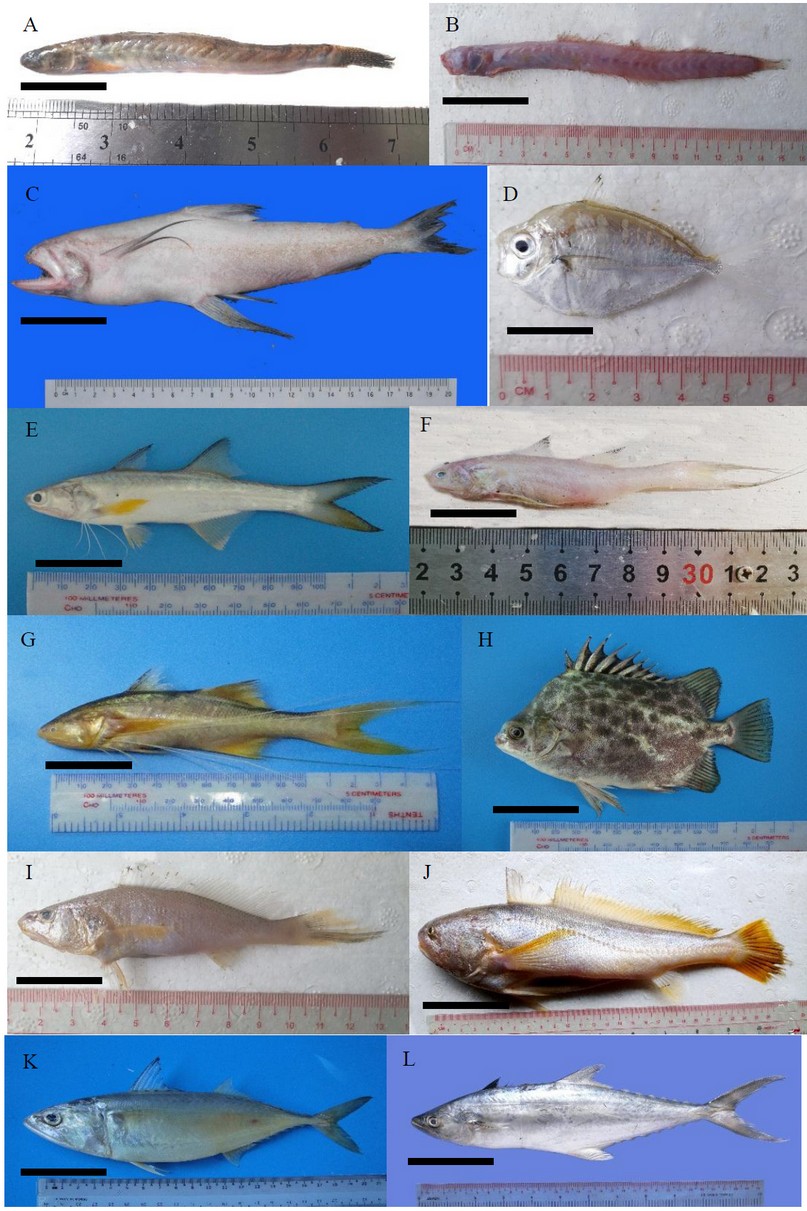
Figure 7 (A-L): A) Gobioides buchanani, B) Taenioides gracilis, C) Harpadon nehereus, D) Secutor ruconius, E) Eleutheronema tetradactylum, F) Polynemus indicus, G) Polynemus paradiseus, H) Scatophagus argus, I) Johnius coitor, J) Otoloithoides pama, K) Rastrelliger kanagurta, L) Scomberomorus guttatus (Scale bar= 5cm)
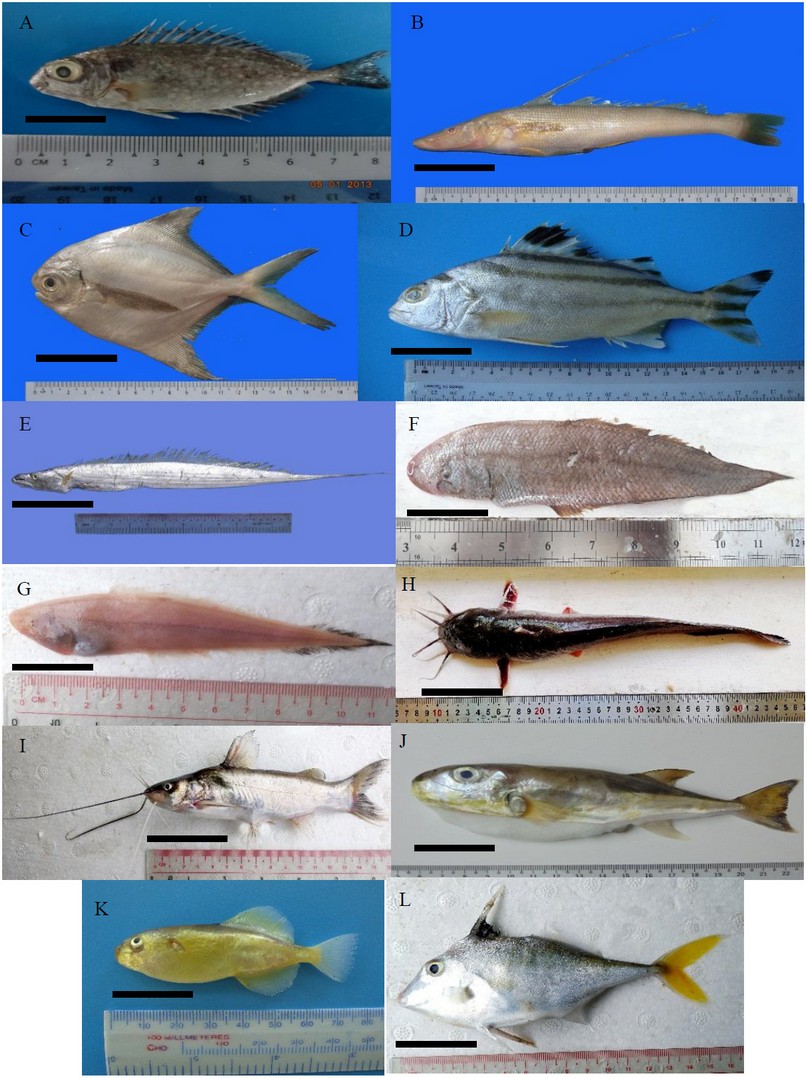
Figure 8 (A-L): A) Siganus canaliculatus, B) Sillaginopsis panijus, C) Pampus argenteus, D) Therapon jarbua, E) Trichiurus lepturus, F) Cynoglossus bilinecatus, G) Cynoglossus lingua, H) Clarias batrachus, I) Mystus vittatus, J) Lagocephalus lunaris, K) Xenopterus naritus, L) Triacanthus nieuhofii (Scale bar= 5cm)
CONCLUSION
In the study, 48 species of fishes were recorded from the three fish landing centers located at the Thanbyuzayat Township, Mon State. The fish under the order Perciformes was found commonly in the study period. During the study, diverse species of commercial fish species; Croaker (Sciaenidae), Hilsa (Clupeidae), Bombay duck (Harpadontidae), and Anchovy (Engraulididae) were found commonly in the study period. They are essential for local people as food and support finance by exporting them to other areas and foreign countries. In all data collections, small fishable sizes were collected from large ones from all study areas.
Acknowledgments
I am indebted to Dr. Aung Myat Kyaw Sein, Rector of Mawlamyine University, and Dr. San San Aye, Pro-Rector, Mawlamyine University, for their encouragement and supports in preparing this work. I am very grateful to Dr. San Tha Tun, Professor, and Head of the Department of Marine Science, Mawlamyine University, for his valuable suggestions and constructive criticisms on this study. I also thank my colleagues, Dr. Naung Naung Oo, Lecturer, Department of Marine Science, Settwe University, and Daw Khin Myo Myo Tint, Assistant Lecturer Department of Marine Science, Mawlamyine University, for their help in field trips and advising and willing helper to me. I also grateful to my pupils, final students, Department of Marine Science, Mawlamyine University, for help in field trips and identified the fish specimens. Finally, my infinite thanks are to my beloved family for their kind and financial support throughout this study period.
REFERENCES
1. Ohnmar Min (2013). Fishery Biology of Sciaenid fishes in Mon Coastal Waters. Unpublished PhD. Dissertation. Department of Marine Science, Mawlamyine University, Myanmar.
2. Carpenter, K. E., Krupp, F., Jories, D.A. and Zajonz, W. (1997). FAO species Identification guide for Fishery purposes. The marine living resources of Kuwiat, Eastern Saudi Arabia, Bahraian, Qatar, and the United Arab Emirates. Food and Agriculture Organization of the United Nations, Rome. 292 pp.
3. Fischer, W. and Bianchi, G. (1984). FAO species identification sheets for fishery purposes Western Indian Ocean (Fishing Area 51). Vol I-VI. Food and Agriculture Organization of the United Nations, Rome.
4. Day, F., F.L.S. & F.Z.S. (1878). The Fishes of India, being a natural history of fishes known to inhibits at the seas and freshwater of India, Burma and Ceylon. Vol. I (Text)-1-778 pp and Vol. II (Atlas), Today & Tomorrow Book Agency, New Delhi, 195 pp
5. Mya Than Tun (2001). Marine fishes of Myanmar (Pelagic and Demarsal). Marine Fisheries Resources Survey Unit. Department of Fisheries. Yangon: 276pp.
6. Sann Aung (2003). Commercial Fishes of Myanmar Seas. Myanmar Academy of Agricultural, Forestry, Livestock and Fishery Sciences: 111pp.
7. Su Su Hlaing (2010). Commercially important ichthyological fauna of the Thanlwin River mouth and Adjacent sea. Unpublished M.Res. Thesis. Department of Marine Science, Mawlamyine University, Myanmar.
8. Cho Cho Latt (2010). Observations on The Fisheries of Anchovies (Engraulidae) of Setse Coast. Unpublished MSc. Thesis. Department of Marine Science, Mawlamyine University, Myanmar.
9. Thu Ya Kyi Zin (2011). Base line data on the Artisanal Fishery of the Thanliwn River Mouth Areas. Unpublished MSc. Thesis. Department of Marine Science, Mawlamyine University, Myanmar.
10. Zin Zin Zaw (2014). A study on Fishery of some commercial fishes in Asin Coastal Areas, Ye Township, Mon State. Unpublished M.Res. Thesis. Department of Marine Science, Mawlamyine University, Myanmar.
11. Thazin Aye (2014). A study on some aspects of Biology of Anchovy Fishes (Family: Engraulidae) in Zeephyuthaung Coastal Areas. Unpublished MSc. Thesis. Department of Marine Science, Mawlamyine University, Myanmar.
12. Min Ye Lwin Oo (2014). A study on some aspects of Biology of Wolf-herring (Family: Chirocentridae) from Zeephuthaung Coastal Area. Unpublished MSc. Thesis. Department of Marine Science, Mawlamyine University, Myanmar.
13. Ei Ei Khaing (2014). A study on some aspects of Biology of Ribbon Fishes (Family: Trichiuridae) in Asin Coastal Area. Unpublished MSc. Thesis. Department of Marine Science, Mawlamyine University, Myanmar.
14. Thandar Aung (2015). A study on some aspects of Biology Status of Carangids (Family: Carangidae) from Tha-baw-seik Fish Landing Centre, Longlone Township, Taninthayi Region. Unpublished M.Res. Thesis. Department of Marine Science, Mawlamyine University, Myanmar.
15. Khin Myo Myo Tint (2015). A study on Ichthyofauna of Ka-byar-wa Coastal Waters, Ye Township, Mon State. Unpublished MSc. Thesis. Department of Marine Science, Mawlamyine University, Myanmar.
16. Yin Yin Win (2016). A study on some fish community in Andin Village, Ye Township, Mon State. Unpublished M.Res. Thesis. Department of Marine Science, Mawlamyine University, Myanmar.
17. Khin Myo Myo Tint (2016). Occurrence of Fish species around Mein Ma Hla Island in the Lower reaches of Bogalay river. Unpublished M.Res. Thesis. Department of Marine Science, Mawlamyine University, Myanmar.
18. Kaung Htet Hein (2017). Fishery Status of Kadonebaw Village in Mudon Township, Mon State. Unpublished M.Res. Thesis. Department of Marine Science, Mawlamyine University, Myanmar.
19. Wint Thuzar Nwe (2017). Fish and Fishery of lower Attran River and Gyaing River Areas. Unpublished M.Res. Thesis. Department of Marine Science, Mawlamyine University, Myanmar.
20. Su Su Hlaing (2019). Commercial fishes of the Thanlwin River mouth and Adjacent waters, Mon State, Myanmar. J. Myanmar Acad. Arts Sci. 17 (4):17-39.
21. Sekhara Ra. J.C., Simhachalam, G. and Sebastian Raju, Ch. (2013). Ornamental Fish Diversity of Lake Kolleru, the only Ramsar site in Andhra Pradesh, India. Bull. Env. Pharmacol. Life Sci., 2 (7): 48- 55.
22. Mohanty, S.K., Mishra, S.S., Khan, M., Mohanty, R.K., Mohapatra, A. and Pattnaik, A.K. (2015). Ichthyofaunal diversity of Chilika Lake, Odisha, India: an inventory, assessment of biodiversity status and comprehensive systematic checklist (1916–2014). The Journal of biodiversity data. 11 (6):1-19.
23. Niloy Kundu, Atreyee Chaudhuri, Sudeshna Mukherjee, Shilpa Sen and Sumit Homechaudhuri. (2012). Seasonal fish diversity under tidal influence in the intertidal mudflats of Indian Sundarbans. Indian J. Fish., 59(4) : 43-52.
Received: 22 June 2020
Accepted: 15 September 2020
Zarni Ko Ko
*Lecturer, Department of Marine Science, Mawlamyine University, Mon State, Myanmar
Corresponding author. [email protected]
